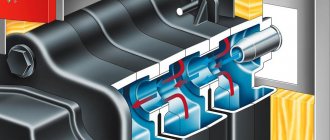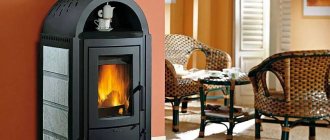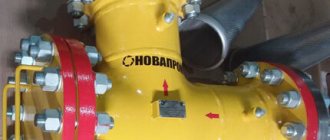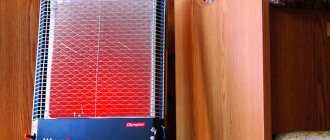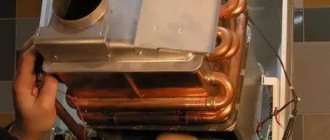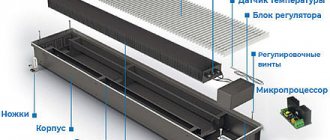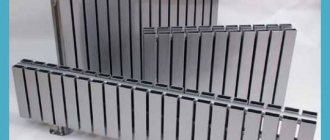Heating private houses with gas is a common occurrence these days, and this is not surprising: it is cheaper than heating with electricity. Many country and cottage settlements have gas mains, and if there is no main line, and its construction is not expected, then autonomous gas tanks are at your service.
A gas convector (catalytic gas heater) has the following operating principle: the air flow passing through the device is heated by gas combustion products (combustion products must be removed from the room). Convectors operate either on natural gas (from main gas pipelines) or on liquefied gas (propane-butane in cylinders or gas holders).
Convectors are used for heating any premises, both residential and utility. That is why when choosing a convector it is important to understand for what purpose it is being purchased. According to the type of installation, gas convectors can be wall-mounted or floor-mounted; below we will consider devices with both mounting options. There are not many manufacturers of this equipment, so some companies will be represented in the ranking more than once.
Types of gas heating convectors
There are three types of gas convectors:
- Permanent installation: With a closed combustion chamber (parapet).
- With an open combustion chamber (chimney).
At first glance, mobile gas convectors seem to be the best solution. This may be so, because a new principle of heat generation is used. They are a casing on wheels in which a liquefied gas cylinder (optional, can be installed externally), a catalyst and the gas radiator itself are packed. There are not many such models. So far, only Italian Bartolini (Primavera and Pullover models) are available on our market.
Mobile gas convector
This device is called a “catalytic gas heater”. It does not use conventional combustion, but catalytic decomposition (combustion on the surface of solids). Thanks to this, there is no usual exhaust or smell, and the gas decomposes almost completely. Since such devices are used in Europe, there is no doubt about their reliability. But so far, they are not particularly popular - the option of combustion without exhaust seems too incredible. In addition, even catalytic oxidation requires the presence of oxygen. This means that it is taken from the air in the room. Well, then, when the catalyst runs out, will I have to buy it? Or change the device completely? In general, there is no real operating experience yet. But we’ll talk about the other two types of gas convectors - parapet and chimney - in more detail.
Top 3. Hosseven HDU-3
Rating (2021): 4.75
The most popular Convector combines reliability, durability and high-speed heating of large areas, which causes high demand for the device.
- Characteristics
Average price: 17,900 rub.
- Country: Türkiye
- Power: 2.7 kW
- Heating area: up to 70 sq. m.
- Gas consumption: 0.28 cubic meters m/hour
- Heat exchanger: cast iron
- Chimney diameter: 85 mm
- Ignition: piezo
This reliable convector is suitable for lovers of durable things: it is made of cast iron, which guarantees a service life of at least 50 years. High-quality gas fittings from the famous Italian SIT were also used. Taking into account the materials of the components, the unit weighs a lot - 23 kg. And since the model is wall-mounted, during installation it is necessary to take into account the working capabilities of the walls and fastenings. Features include an additional fan. It ensures fast and even heat distribution. This function will be especially appreciated by owners of country houses with temporary stays. The device is also perfect for installation in a garage, because it can be refilled with bottled gas and is unpretentious to operating conditions.
Advantages and disadvantages
- Gas fittings SIT
- Durability
- Fast heating
- Heavy weight
See also:
- 10 Best Ceiling Heaters
With open combustion chamber
Gas convectors with an open combustion chamber use oxygen dissolved in the air for combustion. Therefore, the room must be equipped with adequate ventilation. A chimney is required to remove combustion products. That is, the connection is like a traditional boiler of a similar type or a gas water heater. Gas convectors with a closed combustion chamber have an efficiency of about 80%. This is 10-15% lower than most units with a closed combustion chamber.
If you decide to replace a boiler or water heater, buy a gas convector with an open combustion chamber and connect it to existing communications. But usually few people want to build everything anew. After all, for air heating using convectors, you need to install one device per room. It is costly and troublesome to remove such a number of pipes. The second option is to install a more powerful heating device, with air ducts distributed across several rooms. But this requires a design solution, since the heated air must be accumulated somewhere and then distributed to other rooms. Otherwise, it will be too hot in the room where the powerful convector is installed.
Gas convector of chimney type with open combustion chamber
Gas convectors with an open combustion chamber also have advantages:
- work more stably (with a properly constructed chimney and sufficient draft);
- can have greater power (used for heating industrial, commercial and office buildings);
- there is no deterioration in thermal insulation and sound insulation (when installing parapet models, you need to make a hole in the wall).
In general, it’s a good option if you need to organize heating for a small country house, garage, workshop, greenhouse, etc.
Advantages and disadvantages
The advantages of gas heaters include the following:
- The device can be used to heat buildings of any size. There are no restrictions on the purpose of heated premises.
- The unit has optimal dimensions and an attractive design, so it can be used for heating residential buildings.
- To install a heating system, you do not need to lay pipes with a certain slope, install additional equipment and build a boiler room.
- The fuel does not freeze at sub-zero temperatures, so the device is suitable for heating seasonal buildings.
- The efficiency of the heater is higher than that of a modernized convector gas boiler.
- The house warms up much faster than using traditional water systems with heating boilers and radiators.
- This is a non-volatile unit, so it can be used in rural areas where there are frequent power outages.
- The convector is economical and requires minimal maintenance.
- The air heats up quickly because the heat exchanger maintains a high temperature.
The disadvantages of gas heaters include the following:
- Since the device heats only one room, it cannot replace a full-fledged heating system with a boiler and heating radiators.
- To remove the chimney, you will have to make a hole in the outer wall.
- The unit is not suitable for heating hot water for domestic purposes.
- The disadvantages are limited thermal conductivity and power not exceeding 7 kW.
- Gas heaters cannot be called compact devices.
Parapet gas convector
A parapet convector is a gas convector with a closed chamber and a coaxial chimney. It is usually installed under a window to block the area of the most active intake of cold air. The chimney exits through the wall. The hole is made at a certain point, which depends on the design of the model, but most often it is hidden behind the body of the heating apparatus. From the side of the room, the hole is covered with a metal plate, which is part of the installation kit.
Gas radiators of this type are the most popular, as they are easy to install and assemble. When people talk about gas convectors, they usually mean this type of equipment. And all because they can work from both natural and bottled gas, oxygen for combustion is taken from the street, and the exhaust is discharged there. The gas combustion chamber in parapet models is sealed in relation to the room, that is, the exhaust does not enter the room under any circumstances. The peculiarity of this heating equipment is that a coaxial chimney is used. It is also called “pipe in pipe”.
Operating principle of a parapet gas convector
The gas burner is located at the bottom of the heat exchanger. Air from the street enters the combustion zone through the outer pipe, and exhaust air with combustion products is discharged through the inner pipe. Since the air flows are separated only by a layer of metal, the air coming from the street heats up as it moves. Therefore, units with a closed combustion chamber have a higher efficiency: less heat flies into the chimney.
Principle and features of work
How is indoor air heated? The air heated by the burner rises up along the walls of the heat exchanger, heating them, then exits through the internal pipe of the coaxial chimney. The heated walls of the heat exchanger heat the air that is nearby. For its active movement, holes are made in the lower and upper parts in the casing that covers the heat exchanger. Cool air enters through the lower ones, rises up, heats up from the heat exchanger body, and exits through the upper openings.
Gas convector for heating a garage - an almost ideal solution
Some models have built-in fans for more active heating. But you can install the fan yourself. But the blowing mode creates very active air movement, so it may even feel cooler. Especially if you are in an area where air currents pass.
Advantages and disadvantages
The advantages of a parapet gas convector are simple installation. There is no need to build a chimney. You just need to lead the pipe into the hole in the wall. But this hole in the wall is also a disadvantage. First, the hole worsens the thermal insulation. Secondly, sound insulation is reduced. If you stand at the doorway, you can clearly hear what is being said in the room.
For installation you need to make a hole in the wall
The problem with thermal insulation can be solved by filling the gap with heat-resistant insulation (mineral wool with an operating temperature of +500°C). They will slightly worsen the permeability of sounds, but it will not be possible to achieve the same level of sound insulation.
Review of popular models
Nowadays, many companies are engaged in the production of gas equipment, offering their developments and innovations. Each produced model has differences not only externally, but also in terms of technical characteristics. Therefore, you need to choose a device carefully, based on basic indicators. Let's look at the best gas convectors for heating a home and their prices.
Karma Beta 5
An excellent option for heating with gas. The model is characterized by compact dimensions, while being able to heat a room of up to 100 m2. This convector has an efficiency of 89%. Power indicator - 4.7 kW. The desired temperature is adjustable from +13 to +38 °C.
If necessary, the equipment can be converted to liquefied gas. The unit is equipped with safety mechanisms to ensure safe operation.
The only drawback of the model is its high cost. The price of Czech equipment starts from 25,300 rubles.
Alpine Air NGS-50F
The manufacturer of this device is the Turkish company Alpine. Thanks to a power of 4.9 kW, the device is capable of heating rooms up to 49 m2. In the entire series, this model is considered the most powerful, its efficiency indicator reaches 86.9%. The product is equipped with a high-quality Italian Polidoro burner and Sit fittings, which can last about 50 years.
Air NGS-50F is now very popular, which is explained by the price-quality ratio. Both natural and bottled liquefied gas are suitable for operation of the convector. Price - from 25,700 rubles.
Prices for gas convectors Alpine Air
gas convector Alpine Air NGS-50F
Hosseven HP-3
Users prefer this model if they do not need a super powerful heater. The HP-3 device is characterized by modest gas consumption, low power consumption and low weight. If desired, in addition to the main gas, you can also use bottled gas.
The unit is capable of heating a private house with an area of up to 60 m2, and it reaches the required power in just a couple of minutes. The heat exchanger is equipped with thin and elegant walls, so the model has an attractive design that will allow it to easily fit into any interior.
This economical device will cost the buyer 25,600 rubles.
Prices for gas convectors Hosseven
gas convector Hosseven
Gorenje GH 6201
The device cannot boast of a modern design, but it is the optimal equipment for heating a country house or cottage. An efficiency of 87% allows the device to generate 4.2 kW of thermal energy.
This convector model has all the necessary protective mechanisms. For example, if there is no flame, the gas supply automatically stops. GH 6201 is capable of maintaining temperatures in the following range: from +10 to +32° C. Cost - from 17,100 rubles.
How to choose power
Each heating device, and gas convector too, has a line in its description indicating the recommended heated area. The data is given for “average” insulation and standard ceiling heights (up to 2.7 m). If your room goes beyond these parameters, you need to adjust the power up or down.
Power is one of the first selection criteria
If you need to estimate the power of a gas convector in advance, the calculation is carried out by area: 1 kW of power is taken per 10 square meters. But this is if the insulation is “average” and the ceilings are 2.5-2.7 m. If there are differences, we again adjust in one direction or the other. And one more thing: it is better to take power with a margin of 20-25%. The benefit is double:
- in case of extreme cold you will not freeze;
- the unit will almost never operate at maximum power, which will extend its service life.
If a more accurate calculation is needed: taking into account wall materials, region, room location, etc., you can find information here.
Top 9. Karma BETA 2 Mechanic
Rating (2021): 4.28
22 reviews taken into account from resources: Yandex.Market, Otzovik
- Characteristics
Average price: RUB 25,373.
- Country: Czech Republic
- Power: 2 kW
- Heating area: 20 sq. m.
- Gas consumption: 0.24 cubic meters m/hour
- Heat exchanger: steel
- Chimney diameter: 72 mm
- Ignition: piezo
The gas convector Karma BETA 2 Mechanic is praised for its good price-quality ratio. It looks compact and beautiful: through the heat-resistant glass you can observe the process of fire burning in the heat exchanger in real time. At the same time, the heater provides rapid heating of the room, does not burn oxygen and does not require piping. You can maintain a constant temperature at any level from the range of +13 – 38 °C. Safety is guaranteed by the closed combustion cycle of the convector: gas and smoke are discharged into the street without any residue. In previously released batches there were problems with turning on the unit, but in new ones, according to reviews, this defect has already been corrected.
Advantages and disadvantages
- Modern design
- Quality materials
- Low gas consumption
- Safe design
- Full set of permits
- Unpleasant odor at first use
- It takes a long time to set fire
Other selection options
Gas convectors of low power (up to 10 kW) can be wall-mounted or installed on the floor. More powerful ones are always floor-standing. This is due to weight - a heavy unit may not be supported on the wall. Wall-mounted models are supplied complete with brackets, while floor-mounted models are supplied with legs.
Floor models look good too
Heat exchanger
The efficiency of the unit depends on the shape and material of the heat exchanger. As a rule, heat exchangers are made of cast iron or steel. Cast iron ones are more reliable, but they are heavier and more expensive. If the wall has a limit on its load-bearing capacity, the weight may be critical. In other cases, it is better to purchase products with cast iron heat exchangers. But during operation it is necessary to prevent water from getting on the hot surface of the cast iron - even just a few drops can cause the cast iron to crack.
Although the heat exchanger is covered with a casing, water can get into it through the holes
The advantages of gas convectors with cast iron heat exchangers include a longer service life and absence of noise during operation. In a steel heat exchanger, clicking noises occur due to thermal expansion. This happens when the metal heats up and cools down. In living rooms, the periodic appearance of extraneous sounds is very unpleasant.
But steel heat exchangers are made with glass inserts. Through this window you can observe the flame. This, of course, is not as much pleasure as watching a fire in a fireplace, but it is still more pleasant than an ordinary piece of iron.
You can look at the flame while meditating
Burner type
The burner in a closed or open combustion chamber may or may not be modulating. Modeled ones are distinguished by the fact that they smoothly adapt to the requirements of the current moment. But they are more expensive and must be controlled by more complex automation. For this reason, a gas convector with a simulated burner will cost more than a similar unit with a burner that can only operate in two modes: 50% and 100%.
Appearance may vary
Which burner is better? Simulated. What's better? There are several benefits. The first is gas savings, since consumption is only in the amount that is necessary. The second is precise temperature maintenance. When the temperature changes sharply, this is convenient: you won’t wake up sweaty or cold.
Ignition type
Gas burners come with electronic ignition (volatile) and piezo ignition (non-volatile). Piezo ignition is an option with a pilot burner, i.e. a small light should always be on. When the machine is at rest, only the pilot burner is lit. When the main burner is supposed to turn on, it is ignited by the pilot burner.
Better and more economical simulated burner
A gas convector with a pilot burner has two advantages and two disadvantages. First, the advantages: such a gas convector is cheaper and works regardless of the availability of electricity. The disadvantages are as follows:
- Consumes approximately 25% more gas (pilot burner should always be on).
- Less stable job. If the pilot burner is not lit, the unit will not turn on. And it can go out due to clogging, accumulated carbon deposits, lack of traction and a dozen other reasons. It can also be blown away by the wind, etc.
Please note that when choosing a location for installing a gas convector with a coaxial chimney, the prevailing wind direction must be taken into account. It is advisable to choose a place where during the cold season the wind blows infrequently and/or lightly. On the side of the prevailing winds, you can install a plate that will prevent blowing. But all this should be kept in mind before purchasing a heating device.
This is what the chimney will look like from the outside
Gas convector heating devices with electronic ignition are good because the spark is issued upon a control command. That is, it is also produced using a piezo or electric lighter, but only at the moment when it is necessary to ignite the gas. This means less gas consumption, more stable operation. But the downside is the need for power supply. If power outages are rare for you, this should not scare you. If the lack of power supply is not such a rarity, it is better to install an uninterruptible power supply unit paired with a battery. Energy consumption is very small, so you will not need to charge the battery often. By the way, in such models, after the power supply is restored (the duration is unimportant), all user settings (that you set) are saved. This means that after the appearance of electricity, the electronically controlled gas convector will itself analyze the situation and start the convector or not.
Flue gas temperature
The temperature of exhaust gases is an indirect indicator of the efficiency of heating equipment. If the heat exchanger is designed successfully, if the casing is designed correctly, a significant part of the heat goes to heating the air in the room. If mistakes are made, you have to “drown the street.” So we also pay attention to this point.
Data is indicated for the most favorable conditions
The temperature of the exhaust gases is indicated in the model characteristics. If this parameter is not indicated in the specification, there is reason to assume that the efficiency of the device is too low.
Natural (mainline) or liquefied (cylinder) gas
Almost all models of gas household convectors can work with both bottled and main gas. To switch from one type of fuel to another, you need to replace the injector (the size of the nozzle holes differs). Some also require readjustment. The process is described in the operating instructions, but if you are unsure of your own abilities, you can order a unit for a specific type of gas. Then it will come to you with a factory setting for the required type of gas.
When installing on a combustible wall, it must be protected with a fireproof substrate.
Another point: when searching for models and comparing prices, pay attention to the equipment. For some, a nozzle for the second type of fuel is included in the basic kit (models with two injectors usually cost a little more), for others it must be purchased separately. If you may need both sets, it is more economical to buy them together. If only one type of fuel will be used, there is no point in overpaying for an unnecessary part.
Legal and technical details
Of course, when using mains gas, heating costs are lower. It still remains the cheapest type of fuel in our country. But we must take into account that to install a gas convector, just like to install any other gas equipment, a certified project is required. And this is money, time. And the money, I must say, is sometimes considerable.
To install a gas convector on main gas, a project is required
And further. If you are going to heat several rooms in this way, then each one needs its own convector. And the pipes to it will be pulled along the walls. Moreover, the gasket is only open, that is, they cannot be hidden under the casing. Only on top. The installation of a gas convector powered by a gas cylinder does not require a project (if gas is not supplied to the house at all. If there is a gas supply, the project is still necessary).
Features of operating gas cylinders
So, although using bottled gas is more expensive, it is easier. But there are some peculiarities here. A mixture of two gases - propane and butane - is pumped into the cylinder. Share matching is approximately 50/50. One gas evaporates well even at deep minus temperatures, the other at -40°C turns into a liquid state and practically does not evaporate. We don't experience such severe frosts very often, but -20°C can last for weeks. In such frost, although the gas evaporates, it does so very slowly. And only one cylinder is allowed to be stored indoors. So this may not be very convenient either.
We advise you to additionally read the article “Heating with gas cylinders in a private house.”
There may also be a shortage of gas at low temperatures and high flow rates. This is exactly what usually happens. After all, the colder it is, the more heat is required, the higher the fuel consumption. To solve this problem, several cylinders are combined into a single system. In this case, the gaseous fraction is always sufficient.
Combine several cylinders into one system
Additional features and options
Additional features and options are not always superfluous. Some bells and whistles make using a gas convector more convenient, reliable and safe. Others allow you to tailor the work to your own needs or increase security.
- A thermostat, in one form or another, is found in any gas convector. It turns off the device when the temperature near it reaches certain values. That is, the gas convector does not work around the clock, but only when the room temperature drops below the set one. Most units allow you to set the desired temperature in the range from +13°C to +38°C. Models with a lower “starting” temperature will have to be looked for carefully.
- Programmable automation (electronically controlled). Makes it possible to set the operating mode by the clock (cooler at night, warmer by the time you wake up, etc.). More “advanced” models can generally be configured by day of the week. The disadvantage is the higher price.
- Flame control. Available in any model, but it’s better not to forget to check.
- Gas control. Until recently, gas convectors were not allowed to be used in residential premises. In technical terms, please. In the bedrooms - no. Not long ago, changes were adopted in which operation is permitted subject to gas control. In order not to bother with installing the system, it is easier to buy a model with a control function. And safety is a sacred matter, even in technical rooms.
With the development of technology and technology, the list will increase. Surely there are already some new products, but they are not very popular yet - because of their price.
A gas convector is good for heating garages and greenhouses on an ongoing basis, as an additional or main
Top 4. FEG Konvektor GF 35 P
Rating (2021): 4.67
Best heat exchanger design The convector heat exchanger is made of durable heat-treated steel and has a patented shape that ensures high convection.
- Characteristics
Average price: RUB 35,560.
- Country: Hungary
- Power: 4.3 kW
- Heating area: 40 sq. m.
- Gas consumption: 0.459 cubic meters m/hour
- Heat exchanger: steel
- Chimney diameter: 80/180 mm
- Ignition: piezo
Convectors from the oldest European company in Russian realities do not overheat and do not turn off, unlike many of their counterparts in the EU, due to the fact that the automation is specially adapted to the conditions of the CIS countries. The device quickly heats the room with natural gas; high convection is provided by a patented heat exchanger. It is made of heat-resistant high-alloy steel and coated with heat-resistant enamel in two layers. The heater operates quietly, without the clicks and crackles characteristic of gas appliances. If necessary, it can be reconfigured to consume bottled propane-butane. The powerful device is housed in a modest-looking body, and to some, the model seems too angular and large-sized.
Advantages and disadvantages
- Adapted to CIS countries
- Silent
- Conversion to propane-butane
- Unsightly appearance
Manufacturers
In recent years, gas converters Danko, Ross and some others made in Ukraine have become very popular. At a low cost, they are quite reliable. Externally, they are far from ideal, but they look neat. If we talk about models that look great, these are Turkish Demrads. There are only good reviews about them in terms of performance characteristics. At the same time, the similar-priced Eskabe is not encouraging, since its exhaust has a very high temperature, which indicates low efficiency.
Approximate prices for one convector using bottled gas in online stores
In general, a fairly large number of companies have normal reviews from owners:
- Danko (Ukraine)
- Ross (Ukraine)
- FEG (Hungary. There are models with a glass door for viewing the flame)
- Demrad (Türkiye)
- Mora (Slovenia)
- Baxi (Italy)
- [email protected] Emax (Hungary)
- Karma (Czech Republic).
There are many other companies on the market, especially many European ones. In Europe, radiator heating is not so widespread, so they heat themselves with “air heaters” using bottled gas. Branded convectors have a high level of equipment safety, but so do their prices...
Top 2. Hosseven HP-8
Rating (2021): 4.81
Highest efficiency The model has an efficiency of 90%. Minimal heat loss and high-speed heating are ensured by a special design, thanks to which heat enters the air and not onto the coolant.
- Characteristics
Average price: 41,900 rub.
- Country: Türkiye
- Power: 8 kW
- Heating area: 80 – 100 sq. m.
- Gas consumption: 0.72 cubic meters m/hour
- Heat exchanger: steel
- Chimney diameter: 105 mm
- Ignition: electric
The gas device has a wide heating range of 13°C–38°C, and the built-in thermostat maintains the desired temperature. The device can be used in non-gasified areas - the kit includes an adapter for bottled fuel, which is why the model is popular among owners of country houses. The closed combustion cycle convector is equipped with a telescopic coaxial pipe, in which air is taken in, as well as combustion products are removed to the street. Essentially, it is a compact and economical alternative to a traditional chimney. The highlight of the heater is its design. Thanks to the black body, which is 7.5 cm thinner than the standard one, and the heat-resistant window, the device fits into any interior.
Advantages and disadvantages
- Slim body
- Coaxial pipe
- Closed combustion cycle
- High price


